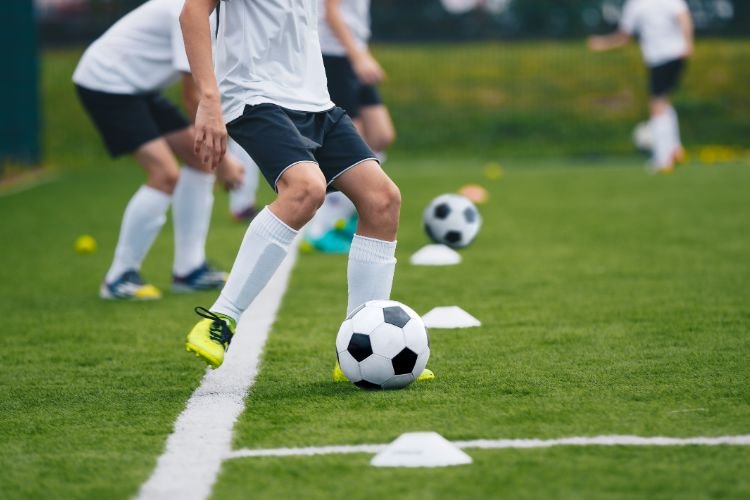Soccer is more than just a game; it’s a passion that drives athletes to continuously hone their skills. Whether you’re a beginner looking to kickstart your soccer journey or an experienced player aiming for professional development, getting the right soccer training is crucial. In this comprehensive guide, we’ll delve into the intricacies of effective soccer training, debunk myths, address FAQs, and provide additional resources to elevate your game.
Understanding the Importance of Soccer Training
Before we dive into the nitty-gritty of soccer training methodologies, let’s explore why training is the cornerstone of soccer excellence.
- Skills Development: Soccer training is the pathway to enhancing fundamental skills such as dribbling, passing, shooting, and defensive tactics.
- Physical Fitness: Soccer requires agility, endurance, and strength. Training programs tailor exercises to improve players’ physical fitness, ensuring peak performance on the field.
- Tactical Awareness: Understanding game strategies, positional play, and teamwork are integral components of soccer training.
- Mental Toughness: Training instills discipline, resilience, and mental fortitude, essential for overcoming challenges during matches.
The Soccer Training Regimen
Now, let’s dissect the key components of an effective soccer training regimen, providing a roadmap for players at all levels.
1. Individual Skill Training

Individual skill development forms the foundation of soccer prowess. Tailor your training sessions to focus on specific skills:
- Dribbling: Practice close ball control, changes of direction, and quick accelerations.
- Passing and Receiving: Hone accuracy, pace, and first-touch control during passing drills.
- Shooting: Work on different types of shots, including volleys, chips, and power shots.
- Defensive Techniques: Master tackling, intercepting passes, and positional awareness.
2. Physical Conditioning
Soccer is an intensely physical sport, requiring players to be in top-notch condition. Integrate the following into your training routine:
- Cardiovascular Exercises: Running, sprinting, and interval training enhance endurance.
- Strength Training: Build core strength, leg muscles, and overall body power through weightlifting and bodyweight exercises.
- Flexibility Drills: Stretching routines improve agility and reduce the risk of injuries.
3. Tactical Training

Understanding the tactical nuances of soccer is paramount. Engage in drills that simulate game scenarios:
- Positional Play: Practice maintaining shape, switching positions, and executing team strategies.
- Game Simulations: Mimic match scenarios to enhance decision-making and teamwork.
- Set Pieces: Train on free kicks, corner kicks, and penalty situations.
FAQs
Q: How often should I train for soccer?
A: For optimal improvement, aim for at least three to four training sessions per week, balancing skill development, fitness, and tactical drills.
Q: Can I train alone, or is team training essential?
A: While individual training is valuable, team training is crucial for developing communication, coordination, and understanding teammates’ playing styles.
Q: Are there age-specific training programs?
A: Yes, training programs should be adapted based on age and skill levels. Youth players may focus more on skill development, while older players emphasize strength and tactical awareness.
Dispelling Myths About Soccer Training
Myth: Training only involves practicing with the ball.
Reality: While ball drills are crucial, a holistic training approach includes physical conditioning, tactical awareness, and mental preparation.
Myth: Talent alone is sufficient; training doesn’t make a significant difference.
Reality: Talent is a foundation, but consistent and targeted training is the key to unlocking one’s full soccer potential.
Additional Resources
Explore these resources to further enrich your soccer training journey:
- U.S. Soccer Federation: The official governing body provides coaching resources, player development initiatives, and educational materials.
- Football Coaches Australia: A platform offering coaching courses, insights, and a community for soccer coaches and players.
- The Soccer Store: A reliable online store for quality soccer equipment and training aids.
Bottom Line
Soccer training is a dynamic journey that intertwines physical prowess, technical finesse, and strategic thinking. Dedication to a well-rounded training regimen, coupled with a thirst for improvement, will undoubtedly propel you toward soccer excellence. Remember, every practice session is a step closer to unlocking your true soccer potential.
Post-training, regularly assess your progress. Set new goals, adjust your training regimen, and stay attuned to your body’s needs. Celebrate achievements, learn from setbacks, and keep the soccer passion alive.

